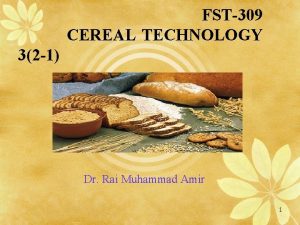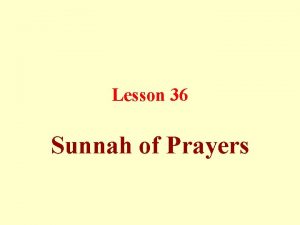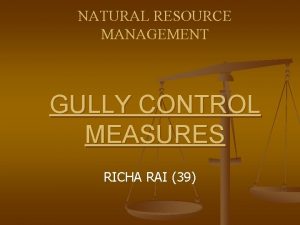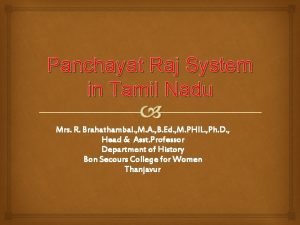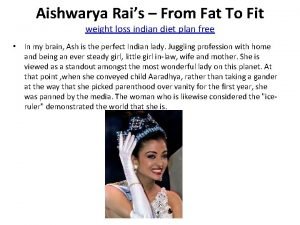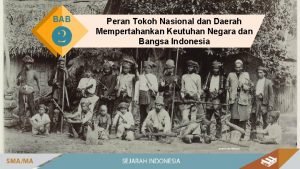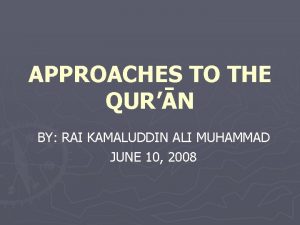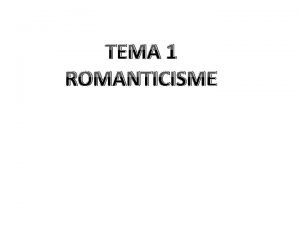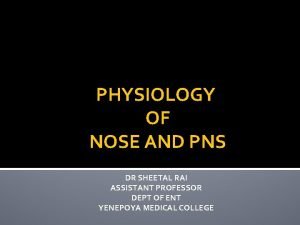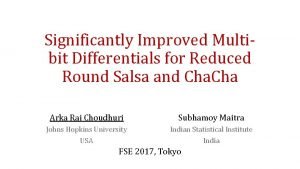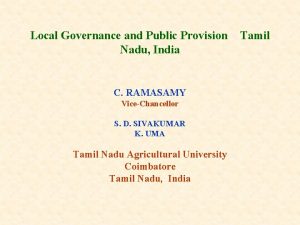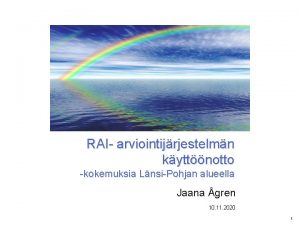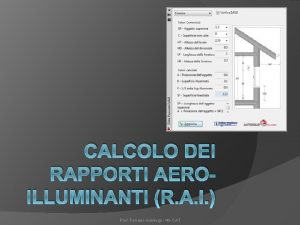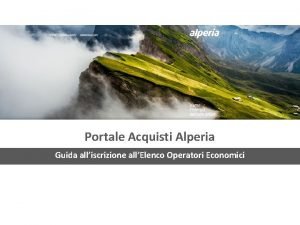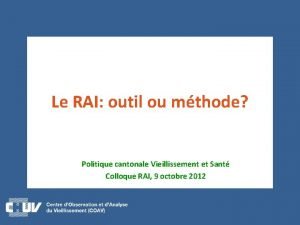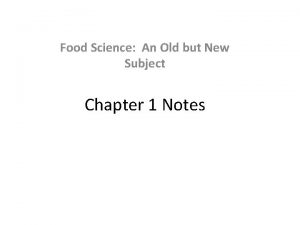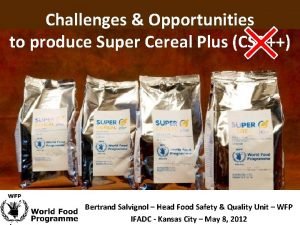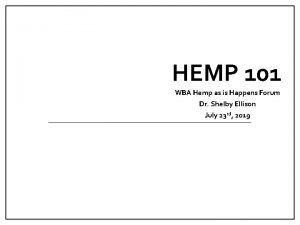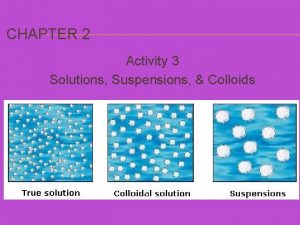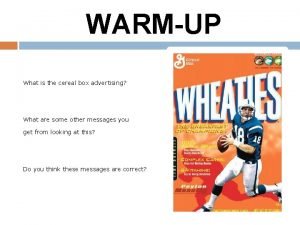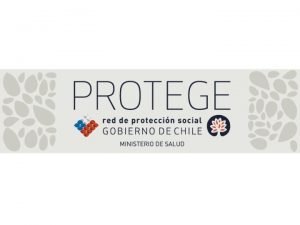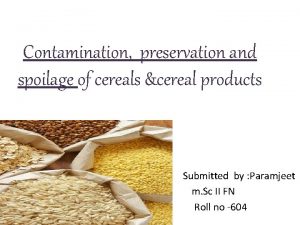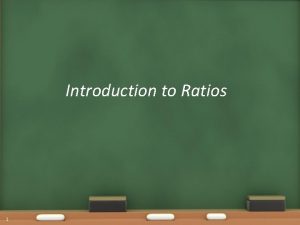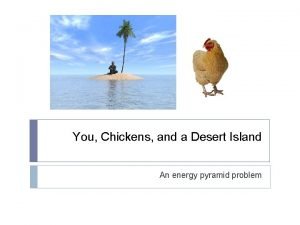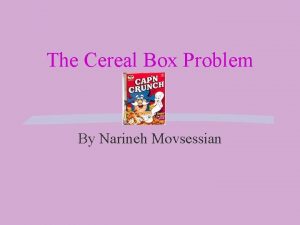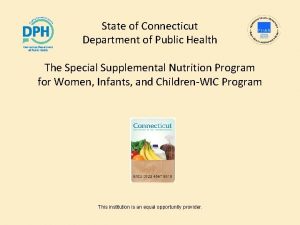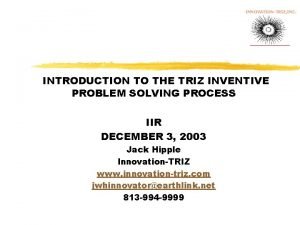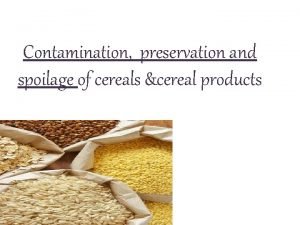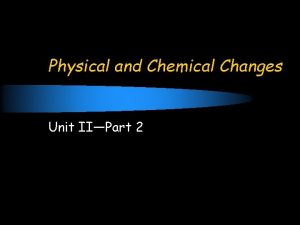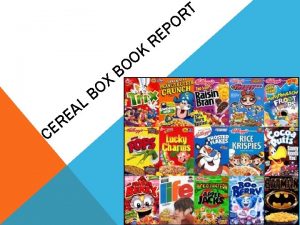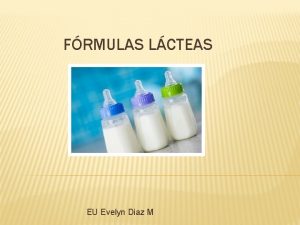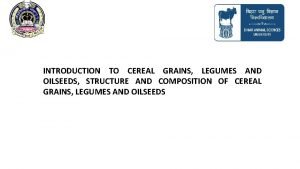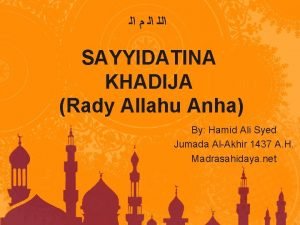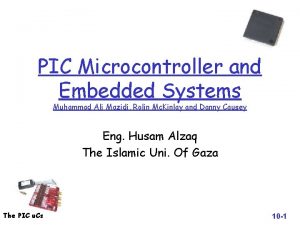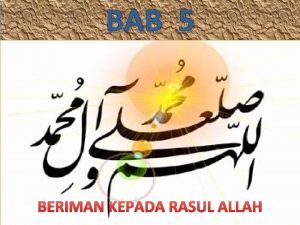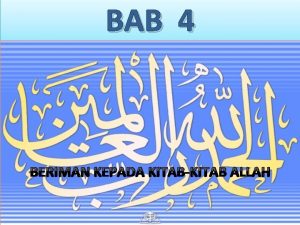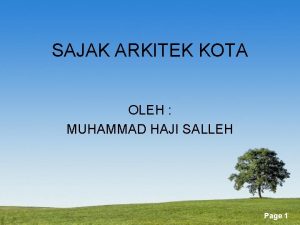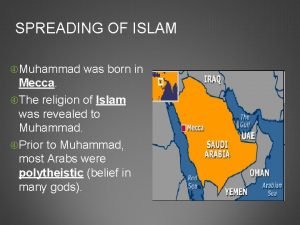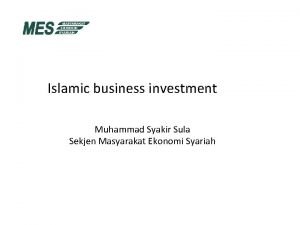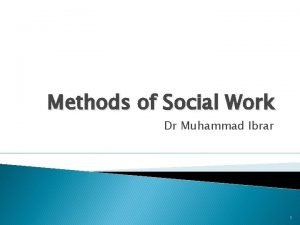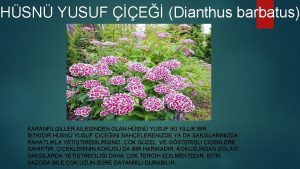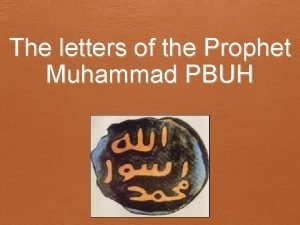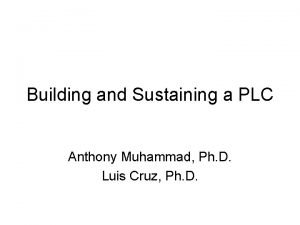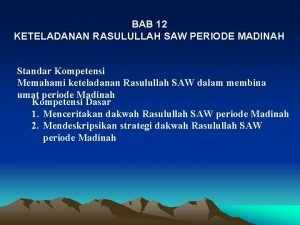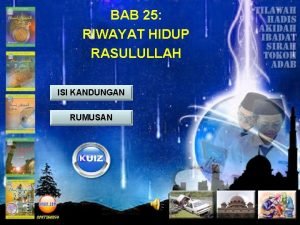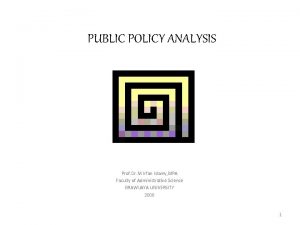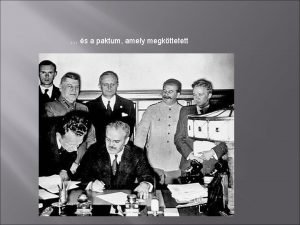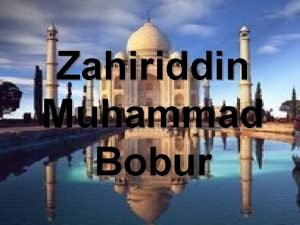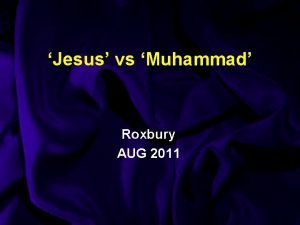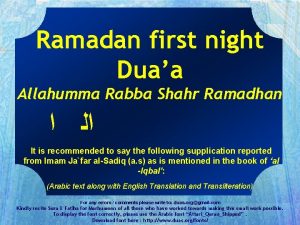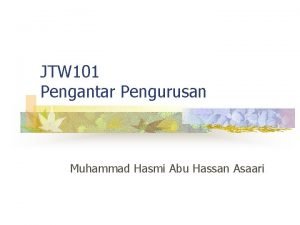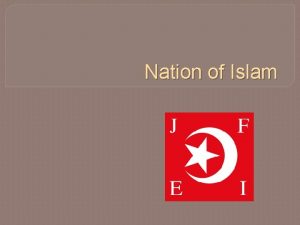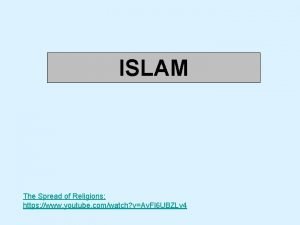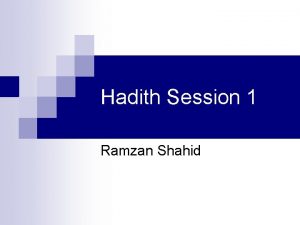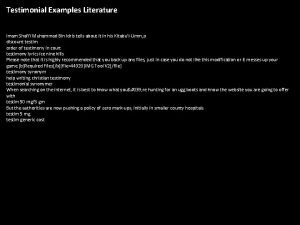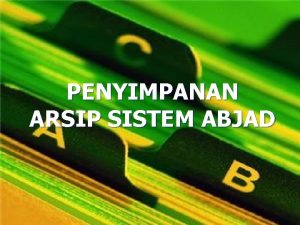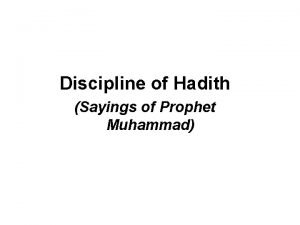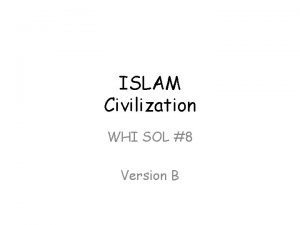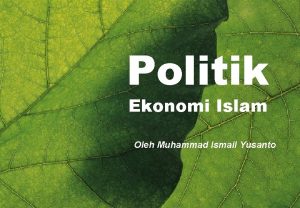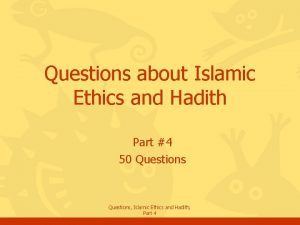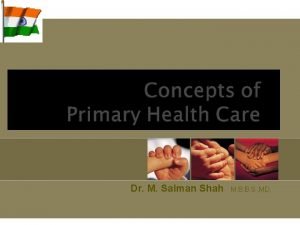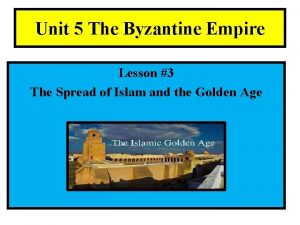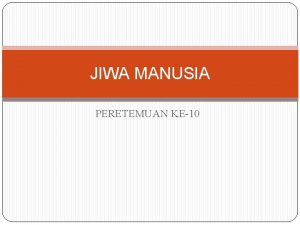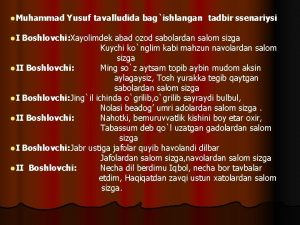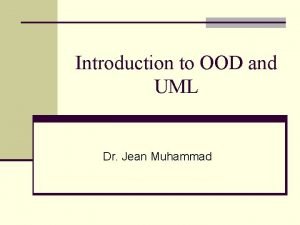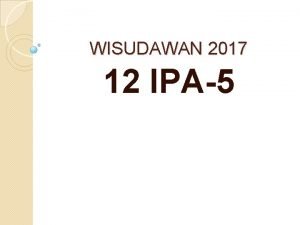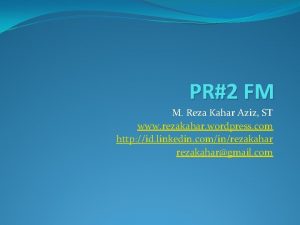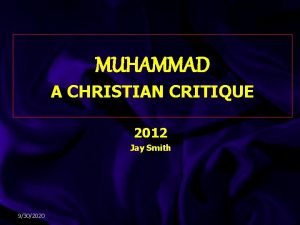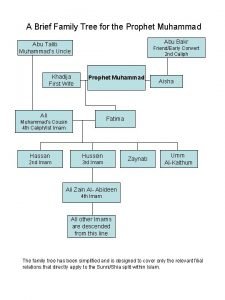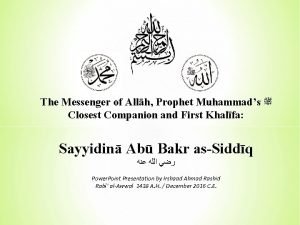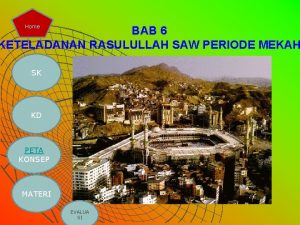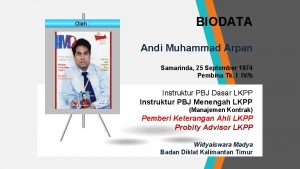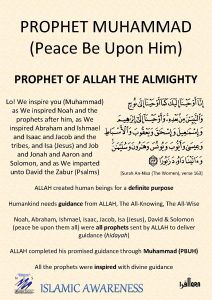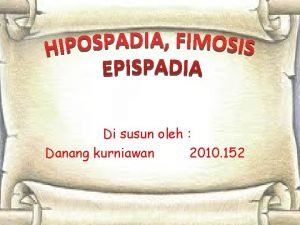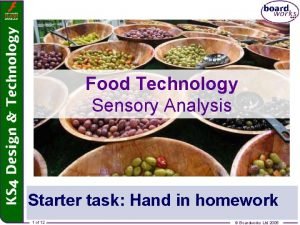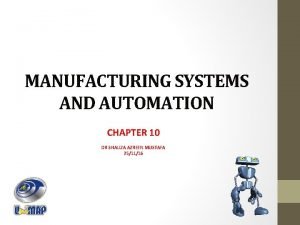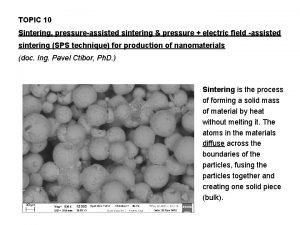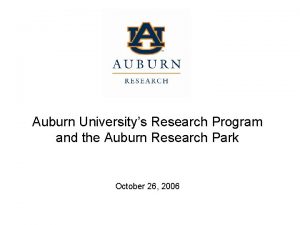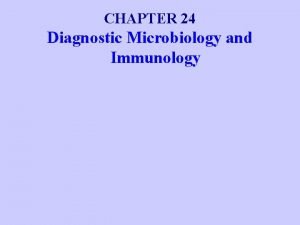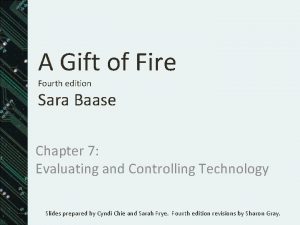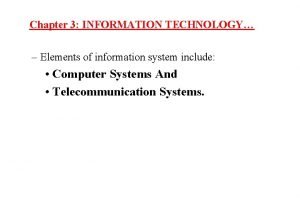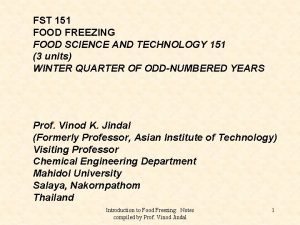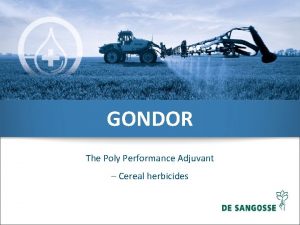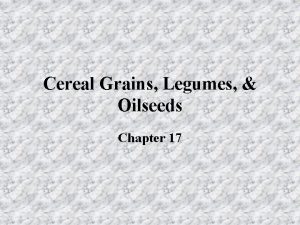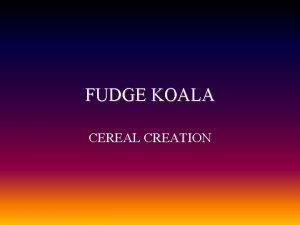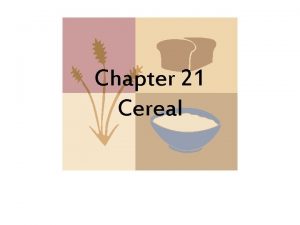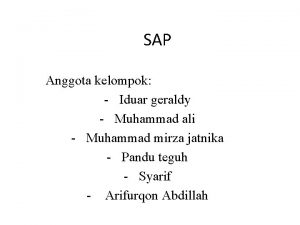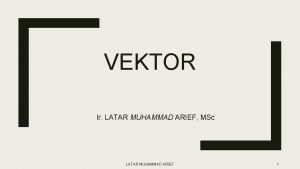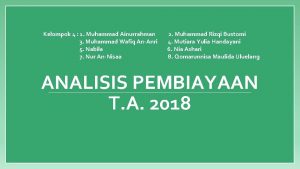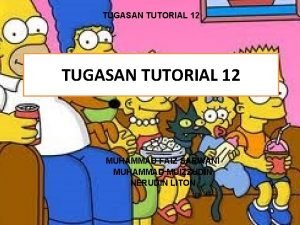FST309 CEREAL TECHNOLOGY 32 1 Dr Rai Muhammad



















































































































































































- Slides: 179

FST-309 CEREAL TECHNOLOGY 3(2 -1) Dr. Rai Muhammad Amir 1

Course contents Theory Cereal grains: importance, classification, production; Composition and nutrition of grains: carbohydrates, fats, proteins, minor constituents. Grain grades and grading; Technical aspects of cereals: storage: basic types, role of moisture; Processing - dry milling: cleaning, blending, tempering, conditioning. Grinding process: types of grinding machines; Sieving process: principles, types of sifters; Milling products: types, quality, treatment, rheology. Wet milling production of starch, oil, protein; Rice: milling, processing, products; The role of cereals in health and disease; History of cereals in diet, Nutritional value of cereals, contribution of cereals and cereal products in diet, cereals in health and disease; Labeling and health claims; Consumer understanding; Future developments: fortification, genetic modifications, gene-nutrient interactions. 2

Practical o Grading of grains; Physical characteristics of cereal grains; Milling of wheat through different mills; Quality assessment of cereals; Rheological properties of dough; Cooking quality of rice; Pasting characteristics of rice flour. 3

Suggested readings o Hoseney, R. C. 1994. Principles of cereal science and technology. American Association of Cereal Chemists Inc, St. Paul, Minnesota, USA. o Karel, K. and G. P. Joseph. 2000. Handbook of cereal science and technology (2 nd Ed. ). Marcel Dekker, New York, NY, USA. o Kent, N. L. and A. D. Evers. 1994. Technology of cereals. Pergamon Press, Oxford, UK. o Wringley L. , Corke H. and C. E Walker. 2004. Encyclopedia of cereals grains. Taylor & Francis Ltd. 4

"To eat is a necessity, but to eat intelligently is an art" 5

Plants for Food o Approximately 350, 000 plant species exist o 195, 000 are flowering plants o 300 used for food o 50 are actively cultivated for food around the world o World wide 17 different species supply most (90%) of our food 6

What are Cereals? • Cereals are grasses (members of the monocot family Poaceae, also known as Gramineae) cultivated for the edible components of their grain (botanically, a type of fruit called a caryopsis), composed of the endosperm, germ, and bran • Cereal grains are grown in greater quantities and provide more food energy worldwide than any other type of crop; they are therefore staple crops 7

• In their natural form (as in whole grain), they are a rich source of vitamins, minerals, carbohydrates, fats, oils, and protein • However, when refined by the removal of the bran and germ, the remaining endosperm is mostly carbohydrate and lacks the majority of the other nutrients. • In some developing nations, grain in the form of rice, wheat, millet, or maize constitutes a majority of daily sustenance. • In developed nations, cereal consumption is moderate and varied but still substantial 8

o Important sources of dietary protein, carbohydrates, the B complex of vitamins, vitamin E, iron, trace minerals, and fiber o The cereal grasses provide the grains that are the staple foods of most of the mankind o Cereals can be grown almost anywhere in the world • Cereals are excellent source of starch. • Cereals also contain proteins. (Gluten & Zein). • A little amount of quality oil is also found in cereals. (Corn oil, Rice bran oil). • Cereals are also a good source of fiber. (Whole cereal floor). • Cereals are cheapest source of energy 9

History o. The word cereal originates from the Romans (goddess named Ceres, the giver of grain). o. Cereals are monocots and part of the grass family (Gramineae or Poaceae). o. The seed is consumed (humans). 10

The Big 17 Species o These 17 species that supply food occupy 75% of cultivated land o Of these 9 are cereals o maize/corn o rice o wheat o barley o sorghum o Millet o oat o rye o Triticale 11

Wheat Triticum aestivum Rice Oryza sativa Corn Zea mays Barley Hordeum vulgare Millet Pennisetum typhodium Sorghum bicolor Oat Avena sativa Rye Secale cereale Triticosecale ( man made) 12

• Maize – A staple food of people in America, Africa, and of livestock worldwide; often called corn or Indian corn in North America, Australia, and New Zealand. A large portion of maize crops are grown for purposes other than human consumption. • Rice – The primary cereal of tropical and some temperate regions 13

• Wheat – The primary cereal of temperate regions. It has a worldwide consumption but it is a staple food of North America, Sub continent, Europe, Australia and New Zealand • Barley – Grown for malting and livestock on land too poor or too cold for wheat 14

• Sorghum – Important staple food in Asia and Africa and popular worldwide for livestock • Millet – A group of similar but distinct cereals that form an important staple food in Asia and Africa. • Oats – Formerly the staple food of Scotland popular worldwide as a winter breakfast food and livestock feed 15

• Rye – Secale cereale) is a grass grown extensively as a grain and as a forage crop • Triticale – (Triticosecale) is a hybrid of wheat (Triticum) and rye (Secale) first bred in laboratories during the late 19 th century 16

THE CEREALS: OVERVIEW o Cereals are the edible seeds (fruits) of plants of the grass family o Critically important food sources for humans and animals o Cereal crops are energy dense, containing 10, 000 15 000 k. J/Kg, about 10 -20 times > than most fruits and vegetables 17

The 9 Cereals o The 9 cereals provide 56% of the earth’s consumed energy and 50% of the protein consumed on earth o Wheat, corn and rice make up 75% of the world’s grain production o Wheat and rice are food staples, corn is a dominant source of livestock feed o Wheat, corn and rice are the most important cereals world wide 18

Characteristics of cereal grains o Good (cheap) source of nutrients o Relatively productive in term of land use o Wide rang of products can be prepared o Longer storage stability 19

World utilization of cereal grains o As food 66% o As feed 20% o Industrial 7% o Seed 7% 20

Utilization of cereal grains in Pakistan o Food o Others 85% 15% o Staple food o Cheapest and principle source of calories o More than 60% protein and calories derived from cereals 21

Contribution of cereals in global nutrition Cereal s 70% Maiz e 22% Wheat 21% Rice 16% Animal & fish products 4% Legumes, 7% oilseeds 6% Roots & Sugar 3% tubers 8% Other s 11% Fruits 2% Other Vegetables & melons 22

Threats to production global cereal • The climatic changes • Diseases and insect pests • Land area decreasing and soil loss increasing • Biofuels are replacing food crops • Post harvest losses • Losses during storage 23

Grains supply chain 24

Cereal Grains and our health o Cereal-based foods may cause problems (gluten intolerance) dietary o Celiac disease, a condition caused by the ingestion of gluten proteins o Not a good sources of quality protein 25

Wheat o Wheat is prominent among the cereals o Unique dough-forming properties o The gluten protein-viscoelastic properties • Major types: o Common wheat (Triticum aestivum) Breads (leavened and unleavened), noodles, breakfast cereals, (processed porridge), cakes, cookies, chapatis, snack foods, bulgur, animal feed, industrial uses o Durum wheat (Triticum turgidum subsp. Durum) 26 Pasta (e. g. , spaghetti, macaroni)

Major cultivated species of wheat • Common wheat or Bread wheat (T. aestivum) – A hexaploid species that is the most widely cultivated in the world. • Durum (T. durum) – The only tetraploid form of wheat widely used today, and the second most widely cultivated wheat. • Einkorn (T. monococcum) – A diploid species with wild and cultivated variants. Domesticated at the same time as emmer wheat, but never reached the same importance. 27

Conti… • Emmer (T. dicoccum) – A tetraploid species, cultivated in ancient times but no longer in widespread use. • Spelt (T. spelta) – Another hexaploid species cultivated in limited quantities 28

Classes used in the United States • Durum – Very hard, translucent, light-colored grain used to make semolina flour for pasta. • Hard Red Spring – Hard, brownish, highprotein wheat used for bread and hard baked goods. Bread Flour and high-gluten flours are commonly made from hard red spring wheat. 29

Conti… • Hard Red Winter – Hard, brownish, mellow highprotein wheat used for bread, hard baked goods and as an adjunct in other flours to increase protein in pastry flour for pie crusts. • Soft Red Winter – Soft, low-protein wheat used for cakes, pie crusts, biscuits, and muffins. Cake flour, pastry flour, and some self-rising flours with baking powder and salt added, for example, are made from soft red winter wheat. 30

Conti… • Hard White – Hard, light-colored, opaque, chalky, medium-protein wheat planted in dry, temperate areas. Used for bread and brewing. • Soft White – Soft, light-colored, very low protein wheat grown in temperate moist areas. Used for pie crusts and pastry. Pastry flour, for example, is sometimes made from soft white winter wheat 31

Nutrition • 100 grams of hard red winter wheat contain about – 12. 6 grams of protein, – 1. 5 grams of total fat, – 71 grams of carbohydrate, – 12. 2 grams of dietary fiber, 32

Conti… • 100 grams of hard red spring wheat contains about – 15. 4 grams of protein, – 1. 9 grams of total fat, – 68 grams of carbohydrate – 12. 2 grams of dietary fiber 33

Conti… In the world about • 65% of wheat grain is used directly as a human food, • 21% as a feed for animals, • 8% as a seed, • 6% wheat grains goes for other industrial purposes. 34

Conti… • In Pakistan about 70% of the total wheat produced is consumed for the production of unleavened flat bread locally known as "chapatti" and its culinary variations like "tandoori roti", "naans", "prathas" and "poories". • 30% of the rest wheat is used for production of other bakery products such as breads, cookies, cakes and pastries etc 35

Rice o Rice is the seed of the monocot plants Oryza sativa • Consumed whole grain, after removal of the bran layers o 90% of the world’s rice production in Asia- developing countries. o Prices vary greatly depending on the type of rice. 36

• It is a staple food for half of the world’s population and provides dietary energy and protein up to 75% to 2. 5 billion people of the world • The rice provides 23% of the global human per capita energy and 16% of the per capita protein • Rice is free of gluten and cholesterol and contains traces of fat and sodium contents. It contains complex carbohydrates and it is easily digestible 37

Cont. . o Basmati scented rice from Pakistan and north-west India get 4 times the domestic price of ‘‘ordinary’’ rice. o Quality grades based on dimensions; long, medium, short o Quality attributes relate to the milled grain: shape, color, translucency, and uniformity, and also the absence of broken grains. o Paddy is de-hulled and milled to remove the bran layers, leaving white grain. 38

Cont. . o Brown rice, less popular for eating, retains the bran layers, together with added nutrients. o Indica types – long, drier, flaky quality o Japonica types- Short, become sticky on cooking, o Products made from rice; parboiled, rice crackers and noodles, rice cakes and snack foods, rice flour, and fermented drinks (sake / rice wine) 39

Pakistani Super Kernal Basmati is famous for its fragrance and delicate flavor Indica (left) vs Japonica rice (right) 40

Maize (Corn) o Cheap form of starch o Major energy source of animal feed o 4 major categories: o Dent maize o Flint maize o Sweet corn o Pop corn dent in the kernel crown hard, round kernels a dent type maize flint type-expands on heating 41

Cont. . Uses o Breakfast cereals o Tortilla o Cornbread o Porridge, snack foods, o A wide range of industrial uses (e. g. , corn syrup, food ingredients) 42

Barley o Prophet Muhammad (SAW) food o Appeared on Greek coins several centuries BC o Staple diet of Roman gladiators, who were known as hordearii (reflecting the origins of the genus name, Hordeum). 43

• Barley is a wonderfully versatile cereal grain with a rich nutlike flavor and an appealing chewy, pasta-like consistency • Its appearance resembles wheat berries, although it is slightly lighter in color • Sprouted barley is naturally high in maltose, a sugar that serves as the basis for both malt syrup sweetener. When fermented 44

• A member of the grass family that serves as a major animal fodder, as a base malt for beer and certain distilled beverages, and as a component of various health foods • It is used in soups and stews, and in barley bread of various cultures • Like wheat and rye, barley contains gluten which makes it an unsuitable grain for consumption by those with celiac disease 45

Barley classification (a) hulled, six-row (b) hulled, two-row (c) hull-less • Hull-less barley have a higher digestibility (94%) than the hulled types (83%). 46

Waxy barley • All the starch is in the form of amylopectin • It is of interest as a possible replacement of tapioca starch. High amylose barley • A high amylose barley, in which about 40% of the starch is in the form of amylose • Useful in the manufacture of malt whisky. 47

Cont. . Uses o Functional food (Beta-glucan) o Malting and brewing (Scotch, Whiskey) o Pearled barley in soups o Bread o Porridge o Animal feed 48

Oat o Compared to the other cereal grains, the oat grain tends to have: o o o Higher contents of protein Lipids Soluble fiber (Beta-glucan) Beneficial hypocholesterolemic properties Manages insulin response in diabetics 49

Uses o Ready to eat breakfast cereal o Oat meal cookies o Porridge o Oat cakes o Cosmetics o Adhesives 50

• Different types of processing are used to produce the various types of oat products, which are generally used to make breakfast cereals, baked goods and stuffings; • Oat groats: unflattened kernels that are good for using as a breakfast cereal or for stuffing 51

• Steel-cut oats: featuring a dense and chewy texture, they are produced by running the grain through steel blades that thinly slices them • Old-fashioned oats: have a flatter shape that is the result of their being steamed and then rolled • • Quick-cooking oats: processed like old-fashioned oats, except they are cut finely before rolling 52

• Instant oatmeal: produced by partially cooking the grains and then rolling them very thin • Oat bran: the outer layer of the grain that resides under the hull. While oat bran is found in rolled oats and steel-cut oats • Oat flour: used in baking, it is oftentimes combined with wheat or other glutencontaining flours when making leavened bread 53

Problem with oat processing o Higher content of lipid (fats) o Significant lipase activity (fat-splitting enzyme) o After milling, fat rancidity, bitterness, and a soapy Taste o To prevent this, it is usual for milled oats to undergo some form of heat treatment to inactivate the lipase activity. This is often done by steam treatment 54

Sorghum and the Millets o Major sources of protein and energy for many people in Africa and Asia • Principal sources of energy, protein, vitamins and minerals for millions of the poorest people in these regions o Grains are used as porridge, boiled in water after grinding o Used as animal feed 55

Rye o Only cereal grain that approaches wheat with respect to bread-making properties o Popular human diet in Europe. o Rye breads, flaked rye o Offers high level of pentosans - soluble fiber o Helps in slimming diets as well as reducing the rate of rise in the blood sugar level Susceptible to contamination with fungi 56

• Rye bread, including pumpernickel, is a widely eaten food in Northern and Eastern Europe • Rye is also used to make the familiar crisp bread • Rye flour has enough gliadin, but not enough glutenin, and therefore it has a lower gluten content than wheat flour, and contains a higher proportion of soluble fiber • Other uses of rye include rye whiskey and an alternative medicine known as rye extract. Rye straw is used to make corn dollies 57

Triticale o Only man made cereal o Formed by crossing wheat and rye o Possesses winter hardiness of rye and baking properties of wheat 58

• Triticale has potential in the production of bread and other food products, such as cookies, pasta, pizza dough and breakfast cereals • The protein content is higher than that of wheat, although the glutenin fraction is less • The grain has also been stated to have higher levels of lysine than wheat 59

Why Triticale is Formed? o Cereal grains are deficient in lysine (first limiting amino acid in cereal grains) o Scientist consider that rye contains relatively higher lysine than all other grains 60

o Wheat is considered as No. 1 food grain crop according to the production and consumption o It possesses the unique properties of forming viscoelastic dough o So Triticale is made to get the following objectives o Higher lysine level o Similar baking quality to that of wheat 61

Nutritional Quality o Essential components provided by cereals o carbohydrates o protein o fats o vitamins and minerals o fiber 62

Nutritional Quality o The starch of a cereal (carbohydrate) provides energy o World-wide, humans acquire over 1/2 of proteins from cereals o Poorer areas consume more cereals than developed areas. Developed areas have less cereals in their diet and more fats, animal protein, etc o Cereals are not an adequate source of protein on their own as they are deficient in certain essential amino acids 63

General composition of cereal grains 64

Comparative nutritive value of cereal grains Wheat Maize Brown rice Barley Sorghum Oat Pearl millet Rye Available CHO (%) 69. 7 63. 6 64. 3 55. 8 62. 9 63. 4 71. 8 Energy (k. J/100 g) 1570 1660 1610 1630 1610 1640 1650 1570 Digestible energy (%) 86. 4 87. 2 96. 3 81. 0 79. 9 70. 6 87. 2 85. 0 Vitamins (mg/100 g) Thiamin 0. 45 0. 32 0. 29 0. 10 0. 33 0. 60 0. 63 0. 66 Riboflavin 0. 10 0. 04 0. 13 0. 14 0. 33 0. 25 Niacin 3. 7 1. 9 4. 0 2. 7 3. 4 1. 3 2. 0 1. 3 Amino acids (g/16 g N) Lysine 2. 3 2. 5 3. 8 3. 2 2. 7 3. 0 2. 7 3. 7 Threonine 2. 8 3. 2 3. 6 2. 9 3. 3 3. 6 3. 2 3. 3 Methionine. 3. 6 3. 9 2. 8 4. 8 3. 6 3. 7 Tryptophan 1. 0 0. 6 1. 1 1. 7 1. 0 0. 9 1. 3 65 1. 0

66

Improvement of Protein and Lysine in Food o In Pakistan more than 60% protein and calories of total requirement are derived from cereals o Soybean is rich in lysine but deficient in methionine. It contains 40% protein o Cereals are rich in methionine but deficient in lysine 67

o First approach is the addition of protein and lysine in food artificially o Second approach is to develop lines that possess high protein and lysine o Hiproley and RISO M 1508 (lines of barley) contain high lysine and protein o Now breeders are working and crossing these to obtain the better varieties o Yield and protein have negative correlation and this is the main hurdle in this work 68

Position of wheat in this respect o World wide there is very less work done to identify the line with more lysine and protein by conventional breeding o Some lines have been developed containing high protein but not higher lysine (ATLAS 66, NAPHAL) o Negative correlation b/w high protein content and yield o Genetic engineering is being used to develop new wheat varieties 69

Wheat Grain Structure & Composition 70

71

PARTS OF A WHEAT GRAIN 1 - Bran o 14. 5% of whole grain o It contain five layers Epidermis Epicarp Pericarp Endocarp Episperm or testa Aleurone cells 72

o o o Pericarp Immature pericarp helps in the transport of nutrients to other parts of grain Mature pericarp gives protection to endosperm High in fiber Low in proteins Low in lipids except rice grain pericarp Devoid of starch except sorghum 73

Episperm or testa o Contain colouring matter that distinguishes the berry as being of red or white Aleurone layer o Help in synthesis and transport of nutrients o Devoid of starch o High in protein o High content of vitamin B o Low in fiber o High in lipid contents 74

2 - Endosperm o 83% of whole grain o High in starch o Low in fiber o Low in ash o Low in lipids except oat o Low in proteins 75

3 - Germ o 2 -3% of whole grain o Reproductive part o High in sugar o Devoid of starch o High in proteins (enzymatic) o High in lipids o High in ash o High in B vitamin except wheat 76

Composition of Wheat Grain 1 - Moisture o At harvesting 8 -13% o Increases in rainy season o Decreases in dry season o Vital role in wheat quality 77

2 -Proteins o Varies from 8 -15% o Variation is due to - Rainfall - Climate - R. H - Fertilizers - Irrigations 78

3 -Ash o 1. 0 -2. 5% o Influenced by - Grain size - Grain shape 4 -Crude fiber o 1 -3. 5% o Influenced by - Grain size - Grain shape 79

5 - Fat o 1 -3% o Sometimes <2% ü 1% protein is removed during milling and some other nutrients are also lost ü White flour is inferior than whole wheat flour 80

Caryopsis/fruit/kernel o Wheat grain is also called Caryopsis o Commonly called as grain or kernel o Caryopsis comprises of fruit coat + seed coat+ seed o Seed comprises of endosperm + germ + seed coat 81

Covered caryopsis • If hulls are remained attached after threshing e. g Rice, Barley, Oat Hull (floral envelop) Naked caryopsis • The caryopsis in which hulls are lost after threshing e. g Wheat, Millet, Maize 82

Enrichment • Addition of nutrients which are lost during processing to fulfill the deficiency is called as enrichment. Fortification • Addition of nutrients which are already deficient in flour is called as fortification. 83

Wheat Quality o Complex term o Can not defined singly o Depends on factors for which it is intended to be used o In general “ wheat quality is the suitability for a specific product” – Suitable-Good quality – Not suitable-Poor quality 84

What is Quality Wheat? For a farmer o High yield o Disease and insect Resistance o Good grade o More selling price 85

For a miller o Less impurities o Less bran o Ease in milling o Less power requirement o Flour yield (% extraction) 86

For a baker o Higher water holding flour o Good loaf volume o Require less mixing time o Soft product 87

For a consumer • Good appearance and colour • Soft product • More shelf life 88

Wheat Marketing - The Present o Processors are becoming more sophisticated – increased automation o Wheat purchased using grading and nongrading or marketing factors 89

Wheat Marketing - The Future? o Increased market demands for specific wheat varieties, quality and performance o Organic wheat o Genetically modified/Non-GM wheat 90

Wheat Grains Grades and Grading Grades Grain grades are listing of characteristics or attributes of grains which are considered to be important in buying and selling of wheat Grading is the process by which specific lots are measured against grades specifications 91

Information Derived from Wheat Grading o Describe the characteristics information of the product o Describe its specific use o Permit buying and selling of wheat without physically inspecting each lot o Promotes efficiency in production and marketing system o Incentive for the producer 92

Criteria for wheat grading 1. Botanical 2. Physical method 3. Chemical method 4. Sensory method 93

1 - Botanical criteria o Variety “ a true breeding genetically homogeneous line that has fixed, well defined genotypical and phenotypical characteristics” o The wheat genus is Triticum and within that genus 3 species are common. 94

Common wheat (Triticum aestivum) – Breads, hard rolls, chapattis Durum wheat (Triticum durum) – Pasta products (noodles, spaghetti, vermicelli) Club wheat (Triticum compactum) – Cookies, cakes, pastries and noodles etc 95

In botanical criteria 3 factors used to determine market class: a) Color o White (amber)- Pakistani wheats o Red- US wheats- Resistant to sprouting b) Hardness (depends on texture) o Soft o Medium o Hard (High protein/ gluten) c) Growth habit o Spring wheats- Pakistan o Winter wheats- Require chilling temp. for 96 Vernalization ( dormancy break)

4 names- based on above 3 factors o Hard Red Spring Wheat o Hard Red Winter Wheat o Hard White Spring Wheat (Pakistani) o Hard White winter Wheat 97

2 -Physical Criteria o Indicative of flour yield o These physical parameters are: o Test weight o Kernel weight o Grain shape and size o Kernel hardness o Grain colour o Vitreousness o Damaged grain o Foreign matter 98

A- Test Weight o Measures wt. of grains per unit volume o Two different units – lb/bushel, kg/hl o Average of our wheat is 60 lbs/bushel, 70 kg/hl o Tells us grain size, shape and also density o By increasing moisture, the test weight decreases because volume is increased but weight is not increased at the same ratio 99

B- Kernel weight o Expressed in wt in grams per 1000 kernels o Gives rough yield of flour o The correlation b/w test wt and kernel wt is generally that if test wt is more, the kernel wt is also high but it is not always true o Yield have more correlation with test weight 100

C- Grain size and shape o Affects mill performance o Size and shape affect the milling yield and machine 101

D- Kernel hardness o The strength of the texture of kernel o Two types of starch granule (small and large) in endosperm o Starch granules are bounded with each other by protein o If bond is strong, grain will be hard o Other factor is the continuity of protein matrix around starch 102

Hardness is measured by: o Particle size index (cyclone mill- 75 US sieve) o NIR o Power required for grain crushing o Noise during crushing 103

E- Grain color – Red or white F- Vitreousness o It is the appearance of kernel which makes it vitreous or non-vitreous o Vitreous kernel is horn like with no air spaces o In case of non vitreous it is opaque or mealy 104

G- Damaged grain o Contains broken kernels, shriveled kernels, insect damaged kernels or disease affected kernels o It affects milling quality o Low in nutrition o Susceptible to disease in storage 105

H- Foreign matter o It contains dust, dirt, small stones and weed seeds o Any impurities in wheat which can be removed by cleaning operation is called as refraction 106

3 - Chemical Criteria A- Moisture content o Important for storage of wheat o At harvesting moisture is less than 10% o For safe storage it should be 12% o If it is > 16%, growth of fungi will take place o Moisture is important for buying and selling o Moisture contents can be determined by oven drying at 105 o. C 107

B- Protein contents o Protein contents have a linear relationship with loaf volume o Depend upon agro ecological conditions and inputs applied o Among commercial varieties it varies from 8 -12% o Baking quality affected by: o Protein quality o Protein quantity 108

Gluten Strength o The prime factor for determining the protein is gluten o Gluten quality in protein determines its baking quality o Gluten strength is related to the ability of flour to produce high volume bread, a well-shaped loaf, and fine crumb structure. 109

o Gluten creates the elasticity of dough and determines its ability to contain carbon dioxide during rising. o Methods for determining gluten quality o Mixograph o Farinograph o Extensograph o Alveograph 110

C- Ash content o Indicate mineral contents in wheat grain o Have indirect relationship with flour yield: Higher the ash contents lower will be the flour yield o Ash contents determine milling quality o Should not be more than 0. 3% in wheat o If we separate bran from flour, we are removing minerals and flour is of inferior quality 111

o Higher bran in flour results in lower loaf volume (bran edges rupture the bread cells) o Ash content depends on grain size and shape- more ash content if: o Small grains o Shriveled grains o Higher ash content effects bread whiteness But- if higher ash content-nutritionally superior products 112

D- Crude fiber o Any plant material which can not be digested by enzymes present in human body is called dietary fiber o Crude fiber in wheat ranges from 2 -3% o High bran contents- higher will be the crude fiber o Similarly shriveled grains have high crude fiber contents 113

Grading Practices in Pakistan FAQ system of grading o Stands for fair average quality o Samples are collected from districts o A committee do grading of samples as grade A, B, C o Price is given on basis of these grades o System is not valid in present day 114

Disadvantages of FAQ System o Now there are so many wheat varieties that they can not be evaluated on the basis of FAQ system o Earlier chapatti was the only product made from wheat. But now there is variety of products made from it, therefore evaluation of grades for each type of product is difficult 115

o Now harvesting and threshing methods have also been changed o No standard procedures in this system o The committee which implements FAQ system is revised every year therefore there is no uniformity in its function 116

Grading Systems Followed Presently o There are two agencies which do present purchase 1. PASCO 2. Provincial Government agencies Criteria for these systems Impurities should be in tolerance limits 117

Tolerance Limits for Different Impurities Dust, dirt o Tolerance limit o Rejection limit 0. 5% 1% Other food grains (oat, barley grains etc) o Tolerance limit o Rejection limit 3% 5% 118

Damaged and shriveled grains o Tolerance limit o Rejection limit 3% 5% o weevil damaged grains o Tolerance limit 1. 5% Fresh-April-Aug. o Rejection limit 3% o Tolerance limit 0. 5% Sep-Oct. o Rejection limit 1% o Tolerance limit 1% Nov-Dec. o Rejection limit 2% 119

Moisture content o Tolerance limit o Rejection limit 10% 11% o If moisture contents are more, there will be attack of fungi which will produce aflatoxin o Aflatoxin production is more at 15 -16% o Black spot on wheat grains-indicate fungal attack 120

Grading of Wheat on the basis of 1. Moisture contents For Grade No. 1 up to 9% No. 2 9% - 10% No. 3 10% -12% 2. Test Weight No. 1 76 kg/hl No. 2 74 -76 kg/hl No. 3 72 -74 kg/hl 121

3. Foreign matter No. 1 0. 5% No. 2 No. 3 1% - 1. 5% 4. Broken and shriveled grain No. 1 up to 2% No. 2 2% - 3% No. 3 3% - 5% 122

5. Other food grains No. 1 1. 5% No. 2 1. 5% - 3% No. 3 3% - 5% 6. Damaged grains No. 1 0% - 0. 5% No. 2 0. 5% - 1% No. 3 1% - 2% Prices of grades Grade No. 1 gets full (actual) price Grade No. 2 gets 2% less than actual price Grade No. 3 gets 5% less than actual price 123

USDA Official Grades of Wheat USDA grade Test Heat Weight damaged % Total damag ed % Foreign material % Shrunken Broken kernels % % 1 60 0. 2 0. 5 3 3 2 58 0. 2 4 1 5 5 3 56 0. 5 7 2 8 8 4 54 1 10 3 12 12 5 51 3 15 5 20 20 124

GRADE REQUIREMENTS FOR CORN Maximum Limits of Broken Corn and Foreign Material Damaged Kernels Heat. Damaged Kernels Moisture Grade Minimum Test Weight Per Bushel (Pounds) U. S. No. 1 56. 0 14. 0 2. 0 3. 0 0. 1 U. S. No. 2 54. 0 15. 5 3. 0 5. 0 0. 2 U. S. No. 3 52. 0 17. 5 4. 0 7. 0 0. 5 U. S. No. 4 49. 0 20. 0 5. 0 10. 0 1. 0 U. S. No. 5 46. 0 23. 0 7. 0 15. 0 3. 0 Total (Percent) 125

126

127

128

129

FARM to FACTORY 130

Storage of Cereals o Cereal grains are amenable to storage for relatively long periods of time o Harvested at a relatively low moisture contents and when stored and protected from insects and rodents, easily store for years o Under ideal storage conditions( low temperature, inert atmosphere), safe storage may be measured in decades 131

o Throughout history, cereal grains have given humans a buffer against crop failure and starvation o In comparison with dairy products, meat and fresh vegetables, cereals are easy to store o If storage conditions are not proper, they can and do go out of condition o Such loss of cereal stores has led to starvation in the past and even today in some parts of the world 132

Basic Types of Storage Ground storage o Grain is harvested once or twice during the year and consumed throughout the year o Storage can vary from the simple expedient of pouring the grain on the ground or on streets up to storage in large concrete structures 133

o Grain is piled on ground during harvest season when transportation equipment is in short supply Underground storage o It offers a number of advantages o Protects grain from daily and seasonal variations in temperature o Construction is relatively simple o Protects grain from insects and molds because of low oxygen and high carbon dioxide contents of interseed air 134

Storage in bags q Bagged grain can be stored in any shelter that protects bags from weather and from predators q Handled with out any equipment q Relatively expensive Bulk storage in bins q Most widely used type of storage today q Bins have variable size q Made up of wood, steel, concrete 135

o When grain is poured in to a bin, it forms an angle from the horizontal that is called the angle of repose o With most grains this angle is about 27 o o Damp grain or very small grain gives a slightly flatter slope o Smaller bins require steeper slope because of the greater friction on the sides of the hopper 136

Factors affecting cereal storage 1. 2. 3. 4. Moisture Insects Rodents Changes during storage 137

Moisture, No. 1 for Safe Storage o It is of the greatest importance in safe storage of grains o Certain species of fungi are the major cause of grain deterioration o Major factors which control the rate of fungal growth - Moisture ( more important) - Time - Temperature 138

o o Fungal growth begins at about 14% moisture Between about 14 and 20%, a small addition to moisture level - Increases the rate of fungal growth - Changes the number and type of species A mass of grain in a bin looks deceptively uniform but moisture content is not uniform through out the bin Grain coming from a single field may vary in moisture content because of 139

- Differences in the soil - Differences in stages of ripeness of grain o Safe storage moisture content of cereal grains depend upon the grain hygroscopic properties o Most damaging factor in grain storage is mold growth o Generally molds will not grow on grain in equilibrium with air of < 70% R. H 140

o Maximum moisture levels for safe storage of major grains o Corn 13% o Wheat 14% o Barley 13% o Oat 13% o Sorghum 13% o Rice 12 – 13% 141

Insects o o o Major problem for storage of grains Consume and contaminate the grain USDA estimated that storage losses due to insects exceed 470 million dollars per year o Insects that live on grain are of two types - Live inside the grain ( hidden infestation) - Live outside the grain 142

o 1. 2. 3. 4. 5. o 1. 2. Species responsible for hidden damage Granary weevils Rice weevils Maize weevils Grain borers Angoumois grain moth Species responsible for outer damage of grain Red flour beetles Saw-toothed grain beetles 143

3. Cadelles 4. Khapra beetles 5. Indian meal moths Control o Most grain damaging insects are of subtropical region and do not hibernate o Damage can be controlled by low temperature < 10 oc o Moisture is another important factor in controlling grain infestation 144

o Moisture contents of 9% or lower restrict infestation Rodents o Next to humans rats and mice are the most damaging animals o Destroy millions of tons of food each year Control o Killing of rodents whether by baits or traps is effective only over short time spans o Control is rodent proofing of buildings and good sanitation 145

CHEMICAL AND BIOLOGICAL CHANGES DURING STORAGE 1. Germination o High germination with vigorous seedlings is important for seed grain and malting barley o For malting, the barley should all germinate at the same time and in the shortest time o The germination of barley decreases during storage as the moisture content deviates above or below 12% 146

o Germination is also greatly affected by the growth of moulds or insect and mite damage 2. Fat acidity and odour formation o Fat acidity increases with storage time and growth of moulds and insects in the grain o Increased fat acidity reduces the milling and baking quality of wheat o Odors produced by moulds, insects, and mites can be carried into the finished food product 147

3. Gluten o Protein content and gluten quality remain constant or increase slightly during proper storage o Large reductions in protein content or gluten quality caused by mould growth will normally be preceded by off-flavors, odors, etc 4. Nutritive changes o Carbohydrates, minerals, and protein content change little if the grain is stored under dry, cool conditions o Vitamin content appears to be unchanged in storage except for vitamin A content in yellow corn, which can decrease as much as 70% during one year of storage 148

Dry Milling o The term “Milling” covers a wide range of processes o In general they are methods of transforming whole grains in to forms suitable for consumption or conversion in to consumable products o Milling schemes are conveniently classified as o Wet milling o Dry milling 149

Dry milling o Objective o Separation of bran and germ from endosperm o Reduction in the particle size of endosperm Wet milling o Based on seperation of grain or compositional constituents o Constituents are protein, starch and lipids o Applicable in case of corn 150

Wheat Milling q Carried out by dry milling q Steps involved in wheat milling are Ø Cleaning Ø Tempering and conditioning Ø Roller milling Ø Flour treatment 151

Cleaning o Wheat arriving in mill contain foreign matter o It includes dust, dirt, seeds of other crops, straw and pieces of metals o These impurities decrease milling efficiency o Cleaning is required to increase milling efficiency 152

Methods of seperating wheat impurities o Cleaning methods based upon different principles o Impurities are removed on the basis of following characteristics o Magnetic properties o Size and dimension o Shape o Specific gravity 153

o o Behaviour in air current Surface friction Electrostatic properties Colour differences 154

Equipments used for cleaning Magnetic Separator o The wheat first passes by a magnet that removes iron and steel particles Separator o Vibrating screens remove bits of wood and straw and almost anything too big and too small to be wheat 155

Aspirator o Air currents act as a kind of vacuum to remove dust and lighter impurities De-Stoner o Using gravity, the machine separates the heavy material from the light to remove stones that may be the same size as wheat kernels Entolitre o Revolves at 800 rpm o Break infested grains and eggs of insects 156

Disc Separator o The wheat passes through a separator that identifies the size of the kernels even more closely o It rejects anything longer, shorter, more round Scourer o The scourer removes outer husks, crease dirt and any smaller impurities with an intense scouring action o Currents of air pull all the loosened material away 157

Color sorter o Color sorting of seeds is common practice in rice milling industry o Seeds are separated from the bulk of grains based on differences in their color o Electronic sensors are used for this purpose Electric field o Separation is achieved by charging particles and placing them in to an electric field o Electrostatic forces cause mechanical movement which used for separation process 158

Tempering and Conditioning Tempering o Addition of water to optimum level and allow the grain to stand for some time to equilibrate moisture contents Objectives o To toughen the bran o To soften the endosperm 159

o There are different requirements for optimum water contents and duration Ø Harder wheat require more water and time for tempering Ø Softer wheat require less water and time for tempering o Hard wheat grains are tempered to moisture content of 13. 5% for 16 -20 hrs o In case of soft wheat the optimum moisture is 15% and time is 8 hrs 160

How to calculate quantity of water req. = 100 - original moisture - 1 x wt of grains 100 - desired moisture 161

Conditioning o. Tempering in conjunction with heat treatment o. Commonly used by millers To modify wheat physiochemical characteristics Heat conditioning o. During conditioning wet wheat is heated by direct application of steam or through radiators at< 55 oc o. Then wheat is dried to milling moisture 162

Vacuum conditioning o Grain is conditioned at 35 oc o Then temperature is reduced to 25 oc within vacuum treatment stages o The pericarp is not dried out, as with conditioners heated by direct application of steam or through radiators o System is absolutely independent of climate o Milling stock characteristics can be easily adjusted to quick changes in temperature and humidity 163

164

Roller Milling o o o Gradual reduction system comprising of break roll and reduction roll systems A pair of rolls accomplishes milling The pair of rolls rotates in opposite direction Difference in speed of rolls is called differential Fast roll rotates 2. 5 times faster than the slower The point at which these rolls approach each other is known as nip 165

q Shearing and crushing of grain take place at this point Break roll system q Objectives are § Tear the kernel open § Flake the bran § Produce mostly middlings § Produce a minimum flour q 4 -5 pairs of rolls q Surfaces of rolls are corrugated 166

q. After passing through pair of rolls the grain goes through sifter q. If it is moving back and forth it is known as simple sifter and if moving in plenary motion then plane sifter 167

168

169

Break Roll 170

q. Size of sieve decreases from top to bottom q. Different actions taking place in break roll system ØSharp to sharp ØDull to dull ØSharp to dull ØDull to sharp q. Corrugations are 10 -12 inches in first roll and 28 -32 in last roll 171

q Slow speed roll hold the material and fast speed roll scrap the material q Sifter comprises of 12 sieves of different sizes q Top is coarser and lower is finer Overs Material which remain at top of sieve Thrus Material which passes through sieve q Sometime material is also sent to purifier 172

q q Reduction roll system 8 -16 pairs of rolls Differential is 1. 5: 1 After passing through each pair of roll, material passes through sifter and purifier Different fractions obtained in reduction system Farina From common wheat Semolina From durum wheat 173

174

q q q Straight grade flour Stream of ground flour obtained from all rolls 72% of total product Permissible amount of ash in flour is 0. 4% It is difficult to sift soft wheat flour because smaller particles interact with each other and form aggregates Short patent flour 45% flour of total product Contain less bran and less fines 175

Long patent flour q 65% flour of total product Cut off flour q 20% flour between short patent and long patent flour Air classification of flour q Flour is separated on basis of particle size Ø 1 -17 um higher protein than parent flour Ø 17 -35 um equal to parent flour Ø >35 um lower than parent flour 176

ISSUES In Wheat Milling o Good quality protein for baking o Gluten strength o Gluten content o o o Milling – high yields/low ash Variety and environment Hard and soft wheats blended Insects in wheat Blending to meet flour specifications 177

Flour Treatment o Flour is treated for o Bleaching o Improving functional properties o Benzyl peroxide, acetone peroxide and chlorine dioxide are used in bleaching o Bleaching is done to destroy carotenoids in flour o Cake flour is mandatory treated with chlorine gas but this flour is not used for bread making 178

o Natural bleaching takes place when flour is exposed to air o The function of oxidizing, maturing and enrichment is to improve the strength of gluten o These processes decrease S-H bonds and increase S-S or double sulfur bonds o ADA (Azodicarbon amide) is common maturing agent o Vitamin C acts both oxidizing and bleaching agent o Acetone peroxide and chlorine act as bleaching and maturing agents 179
 Rai cereal
Rai cereal Ata hi yatu
Ata hi yatu Wa ta izzu man tasha meaning in urdu
Wa ta izzu man tasha meaning in urdu Muhammad computer technology
Muhammad computer technology Rai
Rai Rai cmh
Rai cmh Richa rai
Richa rai Copiii sunt mainile cu care ne prindem de rai
Copiii sunt mainile cu care ne prindem de rai G.v.k. rao committee in tamil
G.v.k. rao committee in tamil Rai diagnostic
Rai diagnostic Naomi rai
Naomi rai Rai narita
Rai narita Aishwarya weight loss
Aishwarya weight loss Peran letnan kolonel i gusti ngurah rai
Peran letnan kolonel i gusti ngurah rai Kamalzar
Kamalzar Rai kamaluddin
Rai kamaluddin Haagen daz slogan
Haagen daz slogan El rai de la medusa comentario
El rai de la medusa comentario Deepcluster
Deepcluster Sheetal rai
Sheetal rai Arka rai choudhuri
Arka rai choudhuri Balwant rai mehta committee
Balwant rai mehta committee Lady rai mummy
Lady rai mummy Vertailukehittäminen
Vertailukehittäminen Binita rai
Binita rai Sudhendu rai
Sudhendu rai Calcolo rai aggetto
Calcolo rai aggetto Clasificacion rai y binet
Clasificacion rai y binet Piattaforma acquisti rai
Piattaforma acquisti rai Naomi rai
Naomi rai Rai oyau
Rai oyau Cereal lactogenic
Cereal lactogenic A cereal formulated from maize sorghum and cottonseed flour
A cereal formulated from maize sorghum and cottonseed flour Cereal packet family sociology
Cereal packet family sociology Homophone for serial
Homophone for serial Cocoa krispies monkey
Cocoa krispies monkey Cereal box spectrometer
Cereal box spectrometer Collective noun beginning with b
Collective noun beginning with b Super cereal plus
Super cereal plus Cereal milk leafly
Cereal milk leafly Shale rock
Shale rock Is cereal and milk a solution colloid or suspension
Is cereal and milk a solution colloid or suspension Thrive cereal
Thrive cereal Serial killer cereal box names
Serial killer cereal box names Cereal box advertisement
Cereal box advertisement Toppers cereal
Toppers cereal Purita cereal
Purita cereal Chalky bread is caused by
Chalky bread is caused by As you push a cereal box across
As you push a cereal box across Ratio of marshmallows to cereal in lucky charms
Ratio of marshmallows to cereal in lucky charms Can chickens eat cereal
Can chickens eat cereal Cereal box problem
Cereal box problem Missouri wic food list
Missouri wic food list Connecticut
Connecticut Separating sand from gravel chemical or physical change
Separating sand from gravel chemical or physical change Triz cereal
Triz cereal Red bread spoilage
Red bread spoilage Is separating sand from gravel a chemical change
Is separating sand from gravel a chemical change Common and proper nouns powerpoint
Common and proper nouns powerpoint Cereal box project
Cereal box project Formula de inicio pnac
Formula de inicio pnac Is barley a legume
Is barley a legume Cereal serial homophones sentence
Cereal serial homophones sentence The prophet muhammad biography
The prophet muhammad biography How many wives of hazrat muhammad
How many wives of hazrat muhammad Mazidi pic
Mazidi pic Prophet muhammad
Prophet muhammad Peta konsep nabi dan rasul
Peta konsep nabi dan rasul Peta konsep
Peta konsep Kazmain roza
Kazmain roza Kewafatan rasulullah
Kewafatan rasulullah Arkitek kota soalan
Arkitek kota soalan Divine comedy muhammad
Divine comedy muhammad When was muhammad born
When was muhammad born Muhammad ismail yusanto
Muhammad ismail yusanto Muhammad syakir sula
Muhammad syakir sula Nasab sebelah bapa nabi muhammad
Nasab sebelah bapa nabi muhammad Fahad subhi mohammed
Fahad subhi mohammed Lesson from the life of holy prophet
Lesson from the life of holy prophet Pengertian kontrol
Pengertian kontrol Brief story of prophet muhammad
Brief story of prophet muhammad How did prophet muhammad died
How did prophet muhammad died Nawaz sharif agriculture university multan
Nawaz sharif agriculture university multan Muhammad ibrar
Muhammad ibrar Muhammad yusuf doppi
Muhammad yusuf doppi Prophet muhammad letters to kings
Prophet muhammad letters to kings Anthony muhammad
Anthony muhammad Dr anthony muhammad transforming school culture
Dr anthony muhammad transforming school culture Muhammad ihsan adfinda
Muhammad ihsan adfinda Muhammad yusro
Muhammad yusro Movarounnahrda tarbiya va maktab
Movarounnahrda tarbiya va maktab Golden words of prophet muhammad
Golden words of prophet muhammad Dakwah rasulullah di madinah berlangsung selama
Dakwah rasulullah di madinah berlangsung selama Rumusan tentang nabi muhammad saw
Rumusan tentang nabi muhammad saw Muhammad ali mbti
Muhammad ali mbti Muhammad amjad saqib
Muhammad amjad saqib Muhammad ali sportsman of the century
Muhammad ali sportsman of the century Dr muhammad irfan
Dr muhammad irfan Nur muhammad taraki
Nur muhammad taraki Siliwangi
Siliwangi Dr muhammad ali yousuf
Dr muhammad ali yousuf Yoz haqida sher
Yoz haqida sher Jesus vs muhammad
Jesus vs muhammad Doa tahajud
Doa tahajud Allahumma sallimni ila ramadan
Allahumma sallimni ila ramadan What is mental health
What is mental health Muhammad hasmi abu hassan asaari
Muhammad hasmi abu hassan asaari Uncle of holy prophet
Uncle of holy prophet Wallace d ford
Wallace d ford Prophet muhammad and khadija relationship
Prophet muhammad and khadija relationship What is islam
What is islam Ayat 31 surah al imran
Ayat 31 surah al imran Quality of prophet muhammad
Quality of prophet muhammad Imam muhammad bin idris
Imam muhammad bin idris Peace and blessings upon muhammad
Peace and blessings upon muhammad Rak sortir dipersiapkan untuk ... rak
Rak sortir dipersiapkan untuk ... rak Allahumma ya rabba muhammadin
Allahumma ya rabba muhammadin Zahiruddin babur
Zahiruddin babur Muhammad ali
Muhammad ali Sunnah of prophet muhammad
Sunnah of prophet muhammad Dr noor muhammad sheikh
Dr noor muhammad sheikh Prophet muhammad
Prophet muhammad Meccans initially resisted muhammad’s teachings because
Meccans initially resisted muhammad’s teachings because Muhammad ismail yusanto
Muhammad ismail yusanto Islamic ethics
Islamic ethics Dr muhammad salman
Dr muhammad salman Akbar the great
Akbar the great Biodata ruqaiyah binti muhammad
Biodata ruqaiyah binti muhammad Gospel of barnabas muhammad
Gospel of barnabas muhammad Shahri ramadan
Shahri ramadan Mohamed father in law
Mohamed father in law Description of prophet muhammad
Description of prophet muhammad Kapan nabi muhammad lahir
Kapan nabi muhammad lahir Peta konsep perjuangan nabi muhammad
Peta konsep perjuangan nabi muhammad Muhammad yusuf ssenariy
Muhammad yusuf ssenariy Jean muhammad
Jean muhammad 5 major world religions and their founders
5 major world religions and their founders Dinda anistya jasmine
Dinda anistya jasmine First child of prophet muhammad
First child of prophet muhammad Muhammad reza kahar aziz
Muhammad reza kahar aziz Jay smith muhammad
Jay smith muhammad Jules masserman muhammad
Jules masserman muhammad Profet muhammed family tree
Profet muhammed family tree Who was the closest companion of prophet muhammad
Who was the closest companion of prophet muhammad Salawat on prophet muhammad
Salawat on prophet muhammad Silsilah nabi muhammad shallallahu alaihi wasallam
Silsilah nabi muhammad shallallahu alaihi wasallam Muhammad ali hero
Muhammad ali hero Peta konsep dakwah periode mekah
Peta konsep dakwah periode mekah Muhammad yusuf maylida kimgadir
Muhammad yusuf maylida kimgadir Biodata andi chairil
Biodata andi chairil Prophet muhammad lineage
Prophet muhammad lineage Muhammad danang kurniawan
Muhammad danang kurniawan Muhammad islam founder
Muhammad islam founder Banu muhammad
Banu muhammad Chapter 6 the world of islam answer key
Chapter 6 the world of islam answer key Star profile template food technology
Star profile template food technology Industrial technology design
Industrial technology design Group technology
Group technology Sources nso july frenchhowell neill technology...
Sources nso july frenchhowell neill technology... Field assisted sintering technology
Field assisted sintering technology Food technology revision
Food technology revision Auburn research park
Auburn research park Natural science grade 6
Natural science grade 6 Waterford kamhlaba vacancies
Waterford kamhlaba vacancies Information systems and communication technologies quiz
Information systems and communication technologies quiz Kiko technology
Kiko technology Technology student
Technology student Artificial telepathy technology
Artificial telepathy technology Thakur college of engineering and technology
Thakur college of engineering and technology Automotive technology sixth edition
Automotive technology sixth edition Hybridoma technology
Hybridoma technology Advancing technology for humanity
Advancing technology for humanity Mid del technology center jobs
Mid del technology center jobs Technology applications
Technology applications Advanced technology microwave sounder
Advanced technology microwave sounder Neo luddite criticisms of computer technology
Neo luddite criticisms of computer technology Touch screen technology seminar
Touch screen technology seminar Information technology chapter 3
Information technology chapter 3 Fluidized bed freezer
Fluidized bed freezer Sample design and technology gcse examination paper answers
Sample design and technology gcse examination paper answers
